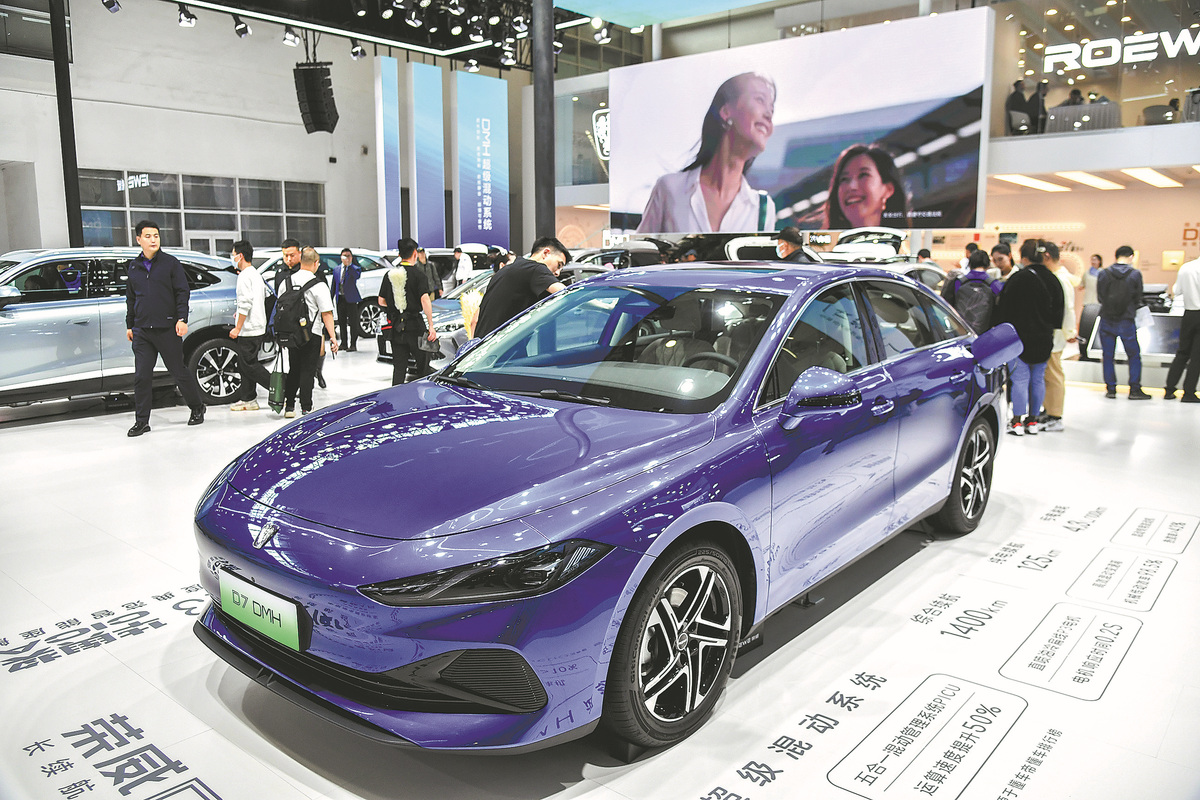
SAIC Motor's Roewe marque showcases the D7 DMH plug-in hybrid sedan at the 2024 Beijing auto show in April. [Photo provided to China Daily]
Plug-in hybrid vehicles are expected to gain in popularity over the forthcoming decade, which has prompted overseas carmakers to turn to Chinese brands for their expertise, said company executives and industry experts.
As its name suggests, a plug-in hybrid model has a gasoline-powered engine and battery-driven electric motors, so it can run on pure electricity, gasoline or both simultaneously.
The combination of two power sources enables such vehicles to consume less fuel than conventional internal combustion engine vehicles and to be less dependent on charging facilities compared with pure electric ones.
BYD pioneered the technology when it launched the world's first plug-in hybrid model, the F3DM sedan, in 2008. SAIC Motor started to develop its plug-in hybrid technology two years later.
Yet in the years of generous subsidies for pure electric vehicles, plug-in hybrids were not a popular choice. They started to gain recognition in 2022, when China's subsidies were last available.
That year saw BYD deliver 946,000 such vehicles, accounting for almost 51 percent of the carmaker's total sales and around 63.6 percent of the Chinese plug-in hybrid vehicle market.
The segment has since been growing rapidly in China, showing signs of reaching the level of electric vehicles.
From January to June this year, sales of plug-in hybrids from all carmakers totaled 1.82 million units in China, up 85.2 percent year-on-year, according to the China Association of Automobile Manufacturers.
In the same period, EV sales grew only 11.6 percent, although they still dominated, standing at 3.02 million units, said the CAAM.
Their popularity has in turn sped up carmakers' effort to improve the technology. In late May, BYD, which is now the world's largest NEV maker, released its fifth-generation plug-in hybrid technology, DM-i.
The technology enables its vehicles to lead globally in a series of key indicators, said BYD Chairman Wang Chuanfu. For instance, its engine thermal efficiency reaches 46.06 percent, fuel consumption falls to 2.9 liters per 100 kilometers even without electric power and the driving range extends to 2,100 km.
At the same event in May, two models powered by the technology, the Qin L DM-i and the Seal 06 DM-i, were launched.
Data from market intelligence provider TrendForce show that 3.91 million plug-in hybrids were sold globally in 2023. Five out of the top 10 best-selling makers were Chinese. Combined, they seized an 82.2 market share, with BYD alone accounting for 33.8 percent.
Yao Chunde, a professor at the State Key Laboratory of Engines at Tianjin University, said Chinese carmakers' leadership in plug-in hybrids is the result of their understanding of the requirements of local car buyers, as not many of them have easy access to charging facilities.
Due to their expertise in the technology, Chinese carmakers have started to be wooed by overseas brands, which Yao said was "unimaginable" in the past.
Volkswagen and General Motors will use SAIC's plug-in hybrid technology in their models for the Chinese market, as the segment is heating up, said Lu Yong, a deputy research and development chief at the Chinese carmaker, when it unveiled its latest technology brand DMH in May.
SAIC has partnerships with both Volkswagen and GM. In past decades, the norm was for Chinese carmakers including SAIC to introduce new technology into China from their overseas partners.
"European carmakers excel in conventional internal combustion engine technology, so they are reluctant to shift the focus of their work to plug-in hybrids. They favor our technology because ours is really advanced in the sector and also because they themselves don't have their own," said Lu.
In a recent test in April, SAIC's Roewe D7 DMH sedan realized a mileage of 1,962 km, with fuel consumption at 2.8 liters per 100 km.
Big technological improvements in plug-in hybrid powertrains are expected to be realized within three years in all five major sectors including the engine, transmission and batteries, said Lu.
Startups including Avatr and Li Auto have plans to roll out range-extended vehicle models this year, which are seen as a variety of plug-in hybrids.
Cui Dongshu, secretary-general of the China Passenger Car Association, said plug-in hybrids, due to their lower fuel consumption, will "definitely" woo away more car buyers from conventional gasoline-powered vehicles.
Ouyang Minggao, an academician of the Chinese Academy of Sciences, agreed, adding that this trend will start in the compact vehicle market and then move to other segments.
"The rising spiral of plug-in hybrids' popularity will not change before 2030, until pure electric vehicles reemerge as the predominant NEV choice for car buyers at around 2035," said Ouyang.
Source: China Daliy
